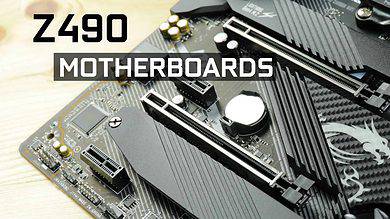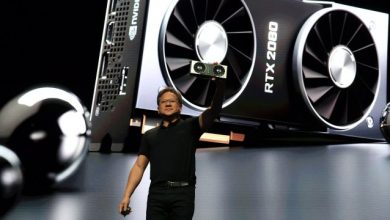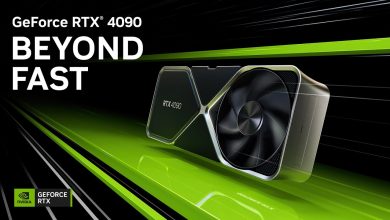Radeon RX VEGA 64
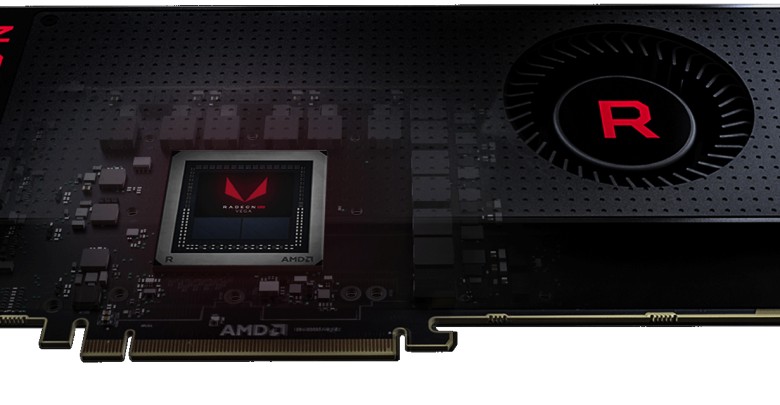
AMD is at it again. Admire its last wave of disruptive tech: The Radeon RX Vega 64!
Scheduled to be launched Aug. 14th, with its latest release of Vega 10 consumer video cards, AMD is deepening its momentum as THE innovative tech company!
After going head first for Intel’s market share in EVERYTHING… AMD is going after NVIDIA’s.
Full disclosure: never been an AMD fan… but my oh my.. am I impressed!
AMD is going for blood, opposing the GP102 (fueling the GeForce GTX 1080Ti) with its latest VEGA 10 architecture.
Its secret: an insanely well-rounded GPU, coupled with the rare, and usually inaccessible HDM2 RAM modules, thus delivering comparable (and even maybe superior) performances than a GeForce GTX 1080Ti.
Oh… I almost forgot… at 25% cheaper!
At the time of this article, a GeForce GTX 1080Ti will run you about 700.00 USD. The release price of a Radeon RX Vega 64 is… 500.00 USD. Got it? But to be fair, there is no way to know this unless we run a practical test. All we have from AMD, so far, is their controlled spec release, ahead of an imminent product launch. So let’s take the below, with a salt of reserve.
But enough talk, let’s take a look at some specs!
What is running the Radeon RX Vega 64 ?
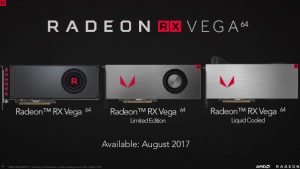
| RX Vega 64 Liquid | RX Vega 64 Air | RX Vega 56 | Vega Frontier Edition | GTX 1080 Ti | GTX 1080 | TITAN X | |
| GPU | Vega 10 | Vega 10 | Vega 10 | Vega 10 | GP102 | GP104 | GM200 |
| GPU Cores | 4096 | 4096 | 3584 | 4096 | 3584 | 2560 | 3072 |
| Base Clock | 1406 MHz | 1247 MHz | 1156 MHz | 1382 MHz | 1480 MHz | 1607 MHz | 1000 MHz |
| Boost Clock | 1677 MHz | 1546 MHz | 1471 MHz | 1600 MHz | 1582 MHz | 1733 MHz | 1089 MHz |
| Texture Units | 256 | 256 | 256 | 256 | 224 | 160 | 192 |
| ROP Units | 64 | 64 | ? | 64 | 88 | 64 | 96 |
| Memory | 8GB | 8GB | 8GB | 16GB | 11GB | 8GB | 12GB |
| Memory Clock | 1890 MHz | 1890 MHz | 1600 MHz | 1890 MHz | 11000 MHz | 10000 MHz | 7000 MHz |
| Memory Interface | 2048-bit HBM2 | 2048-bit HBM2 | 2048-bit HBM2 | 2048-bit HBM2 | 352-bit G5X | 256-bit G5X | 384-bit |
| Memory Bandwidth | 484 GB/s | 484 GB/s | 484 GB/s | 484 GB/s | 484 GB/s | 320 GB/s | 336 GB/s |
| TDP | 345 watts | 295 watts | 210 watts | 300 watts | 250 watts | 180 watts | 250 watts |
| Peak Compute | 13.7 TFLOPS | 12.6 TFLOPS | 10.5 TFLOPS | 13.1 TFLOPS | 10.6 TFLOPS | 8.2 TFLOPS | 6.14 TFLOPS |
| Transistor Count | 12.5B | 12.5B | 12.5B | 12.5B | 12.0B | 7.2B | 8.0B |
| Process Tech | 14nm | 14nm | 14nm | 14nm | 16nm | 16nm | 28nm |
| MSRP (current) | $699 | $499 | $399 | $999 | $699 | $599 | $999 |
Let’s start with that. There will be sorts of cards:
- The 64 edition (3 models)
- the 56 edition (1 model)
They are all based on the Vega 10 GPU, the real star of this release.
The RX 56 aims to compete directly against the GTX 1070, as the 64 models aims to compete against the GTX 1080 and possible the GTX 1080Ti. In both cases, AMD wants to impose itself by proposing, at least, equivalent performances for a substantially lower price.
The RX Vega 64, 64 Limited Edition and 64 Liquid cooled edition. All run the same GPU, the now released VEGA 10. It is no longer a secret… this thing is a monster! A monster pushing the boundaries of the 14 nm manufacturing process… packing an insane 12.5 B transistors on its die. More than any other single die produced by Nvidia.
Don’t be fooled by the sober amount of video cards released (in all and for all, the three cards above are really the same card with different OC configuration). There will be more, and the Christmas release is already buzzing.
Is it realistic thought? Well… let’s see:
Let’s take a closer look to 2 components common to all the Cards:
- The GPU : Vega 10
- The memory : HBM2 RAM
VEGA 10 (The GPU)
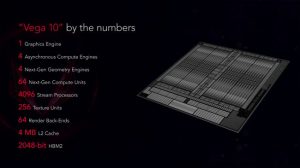
14 nm manufacturing process is key here. It means that AMD can squeeze more transistors in its GPU and these transistors need less electricity to run. In comparison, the latest Nvidia’s 10 series are manufactured at 16 nm.
In short, the more transistors your GPU has, the more computing you’ll get out of it. And it shows big time! TFLOPS wise, the Vega 10 64 outperforms the GP102 (1080Ti and TitanX pascal) by 20%.
That’s not all. The number of Cores boasted by the Vega 10 does not surprise me: 4096 compared to the 3584 deployed by the 1080Ti. The same amount that the R9 Fury X (Fiji architecture) use to show.
Well optimized a games can now compute a richer environment! But with such a higher transistor base density, every core is significantly more powerful.. much much more powerful! And that will translate in richer game environments, stronger independent computing stream to deliver smoother individual effects.
In short, Vega 10, on its own, should really get Nvidia to rework its current and next year’s strategy.
HBM2 (The RAM)
But what is a great GPU, if it not fed enough data, fast enough? That’s where the HBM2 memory comes in.
HBM2 memory is usually found in production video hardware (i.e.: Quadro), simply because it is much much more expensive to produce and buy.
HBM2 is all about scalability and bandwidth debit.
Consider this, whilst GDDR5X RAM (which equips all of the Nvidia 10 Series) outputs up to 480 GB/sec, HBM2 Ram theoretically could outputs up to 1024 GB/sec, but in our case, the Vega 10 will bottleneck it to 484 GB/sec.
They also have a greater silicon density, hence considerably small than GDDR5X, and have a much much higher BUS bit, meaning that it can do more with a much lower frequency clock, and therefore a more energy efficient and cooler components.
I’ll add that HBM2 memory has a RIDICULOUSLY low latency compared to GDDR5X Ram, and that is, by all means, the way forward from now on.
So here you have it… Vega 10 is a great GPU, but it only is special, once you couple it with HBM2 Ram.
CONCLUSION:
14 nm manufacturing process couple with HBM2 memory… what a bold move coming from AMD! It shows both masterings in its engineering abilities and ambition for itself. This is a new generation of video gaming hardware on its very own! I do not see how Nvidia will respond to that!
In Gaming applications:
Hard to say since the video cards are not yet released. But based on specs published by AMD so far, the Vega 64 should indeed, be able to trade blow with the 1080 (GP104) and 1080Ti (GP102) to a much lower price (25% less). I will be making a full review on the Vega 10 as soon as I receive one myself, so keep posted!
But one thing is sure!
AMD continues to punish its competition! Either on the CPU market (Intel) or, as now, on the lucrative high-end video card scenery. For a time, things seemed to be in its right order. Intel had not released anything of interest since 2014 (i7-4790K), but no-one seemed to pay attention to the consumers continual groaning, and Nvidia thought its last 10 series GPUs breakthrough, would bring it some downtime and could enjoy a little summer breeze.
How wrong they were!
In both cases AMD has unleashed, wave after the other, game-changing products, pushing the all computer industry to a boiling point.
This year alone, Intel scheduled the release of 3 major families of CPUs. Kaby Lake, barely 8 Months old, will already be replaced by the Coffee Lake and already cannibalized by some of the X-series Intel CPUs. Same for the motherboard chipsets… Z270 has barely hit the shelves, the Z370 is scheduled for a Q3 release… and both are not impressive, to say the least.
I, for one, could not be happier! I haven’t seen such ebullition since 1994 and the tripartite war between Intel, the now-defunct Cyrix, and AMD. And it is not without nostalgia, that I roam the net, reading of that titanic and beautiful face off that these two seems to have every 20 years!.

